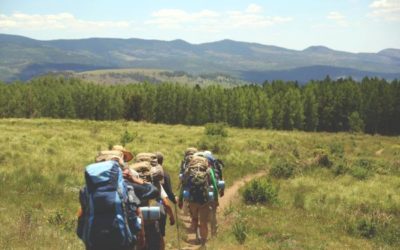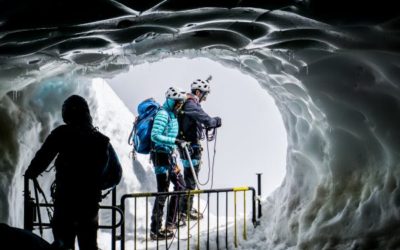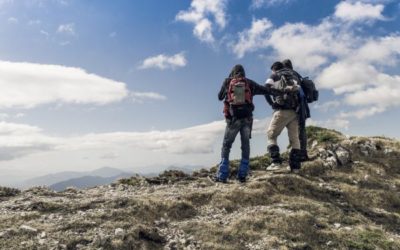Comfort Zone: Model or Metaphor?
I recently read through an interesting research paper called, Comfort Zone: Model or metaphor? written by Mike Brown, of the University of Waikato (Australian Journal of Outdoor Education, 12(1), 3-12, 2008). The paper has a lot of merit. It also raises some controversy as to whether the comfort zone model is still a credible model for facilitating outdoor adventures. Since this paper challenges a widely embraced theory in the field of experiential learning, I felt like there is a need for a response in defense of the comfort zone model. Yet my reasons for supporting the comfort zone model may surprise some wilderness leaders.
I remember when I started leading people on wilderness adventures in 1992 and someone introduced me to the idea that people probably have this thing called a “comfort zone”. That in essence, people need to be nudged out of their warm nest in order to discover they can “fly” (i.e. personal growth requires facing and overcoming our fears). Since then I have become even more convinced that the “Comfort Zone” model is a useful experiential learning tool for outdoor leaders to be aware of in facilitating adventures with people. I also believe that this model, can be supported not only in modern educational literature and empirical research, but also through studying adventure based learning theology.
Yes, One Can Take Comfort Zone Theory too Far
I first want to say that I really appreciate thoughtful folks like Mike pushing back a little on widely accepted norms to make sure that what was true in the past is still true today about outdoor educational theory. To start, I agree with Mark that, “behaviour in an adventure education context may be a poor predictor of behaviour in non-adventure education specific contexts. The placing of a student in a challenging position which elicits a particular behaviour does not necessarily mean that they are learning (Broan, 7).” I agree it is taking the “comfort zone” theory too far to assume that behavior observed in adventure settings will generally transfer to life back in one’s normal life routine. I believe follow up back in the city after a transforming adventure is especially needed to help the participant know how to transfer what they learned to their normal everyday life.
Yes, Emotional Risk is Hard to Assess & Outdoor Leaders Need More Training in How to Assess Emotional Risks
I also agree that emotional risk is hard to assess and that outdoor leaders receive far too little instruction in ways to assess emotional risk (Brown, 4). I do however have a couple points of respectful critique to this paper: 1) Although wonderfully researched and quite compelling, this paper is almost exclusively concerned with “emotional risk” of participants. This is a perfectly valid and needed focus in adventure education, but there are other types of risk that in my opinion need to be equally considered before we dismantle or reframe “comfort zone” theory into a potentially toothless metaphor, i.e. physical risk, intellectual risk, relational risk, spiritual risk, etc. 2) An assumption underlying this paper is an argument from “silence” from participants, which in my opinion is insightful, yet not strong enough to give credence to discrediting comfort zone pedagogy altogether. Brown writes: “I suggest that the adoption of the comfort zone model and the assumptions that underpin it have less than desirable consequences in terms of student engagement, psychological well-being and emotional safety. As educators we hear the success stories and vocal affirmations but what about the silences and unspoken thoughts that are subsumed in the rush for appropriate closure of an activity? (Brown, 10, italics mine).” Although I appreciate and am personally challenged by Brown’s push for sensitivity toward people’s emotional risk quotient, an argument from silence does not outweigh the “success stories and vocal affirmations” that we do hear from participants. In fact I believe those success stories and vocal affirmations are often empirical evidences that support comfort zone pedagogical theory, rather than discredit it.
Reasons to Keep the Comfort Zone Model in the Outdoor Leadership Toolbox
I do not know Dr. Brown personally, but I would guess from his diligent research that we share a common desire to see participants challenged and transformed through adventure education. And although I agree and affirm many of Brown’s important questions (like his exhortations that we need to assess emotional risk more appropriately), I would like to offer a perspective that may keep the comfort zone model in our toolbox as a valid pedagogy for those of us who are passionate about leading others in adventurous pursuits.
Ancient Educational Literature Worth Considering | How the Bible Supports Aspects of the Comfort Zone Model
I have been an outdoor educator for over twenty years, and I’ll just say at the outset that the perspective I will offer below might be pushed aside by some outdoor educators because it is based upon ancient literature rather than modern empirical research techniques, but nevertheless I think there is an important viewpoint that is often missed or ignored.
The abstract of this research paper states, “The perpetuation of this model which uses risk to promote situations of disequilibrium/dissonance does not find strong support in educational literature. It is therefore suggested that the comfort zone model be reframed as a metaphor, for possible discussion post activity, rather than being used as a model to underpin programming and pedagogy in adventure education settings.” I argue that one body of “educational literature” that is widely ignored in experiential learning and outdoor education curriculum is biblical literature. Some will dismiss my perspective because they might question the validity of the Bible, and although I am qualified to defend the Bible’s credibility as a reliable source of historical and educational import, this is beyond the scope of the point I want to make.
Now getting to the point. I recently published a book called, Christian Outdoor Leadership: Theology, Theory, and Practice. In chapter 3, I present research from the biblical literature that supports the “comfort zone” paradigm as a model to, “underpin programming and pedagogy in adventure education settings” (to use the terminology from the abstract in conversation). I do not think that the comfort zone model should be relegated or “reframed” to “metaphor” status for several reasons, one of which I will present below.
A widely recognized theme in both the Hebrew Scriptures (Old Testament) and the New Testament is how God uses trials to expand people’s trust. I concede that the term “comfort zone” is not used in the biblical literature, but even under the most rigorous scrutiny, the theology of trust-formation found in the Bible can be directly applied to the most common usages of “comfort zone” pedagogy. I will readily admit at the outset that my reasons for advocating the comfort zone model do not come from a desire to support Pannicucci (2007), or Piaget’s theory of cognitive development (these are helpful human psychological perspectives yet Brown challenges them fair enough). Rather I see the comfort zone model supported in the way God relates to Israel at times in the Old Testament biblical text, and the way Jesus Christ related to his disciples on some occasions in the New Testament. Below are two excerpts from my book that present some initial perspective on how the biblical literature (which in my view is credible educational literature that needs to be considered) addresses this idea of “comfort zone” pedagogy.
Trials Expose Unbelief
Plain and simple: trials expose unbelief and promote real belief. Time and again, belief is shown to be true or false in the wilderness, and trials are an instrument to expose whether we fear God or man. By removing familiarity, trials also have a way of expanding our comfort zones and keeping us humble. Following [God] is not a walk in the park all of the time. We all have rough edges that need to be rubbed off, and we all have sinful tendencies that are at odds with the desires of the Spirit. The spirit is willing, but the flesh is weak. As we look at the theme of trials or testing in the Scriptures, it becomes strikingly obvious the wilderness is a favorite place for God to get our attention. [God] is after our fidelity to him, and through the trials of Israel in the wilderness of Sinai we learn that perseverance is an indicator of covenant relationship.
God intentionally tests us through various forms of resistance to establish our belief and integrity. Through the process we learn he is the One who sets the terms of discipleship, not us. When pushed, we might want to push back at God, but in his perfect wisdom he questions and stretches us in such a way that draws us nearer to him rather than causing us to run away. Job, Sarah, Abraham, Peter, and Paul are all prime examples of those who have learned obedience through suffering. Each went through a process of disorientation and re-orientation in the wilderness. As God adds the salve of grace to the struggle of our trials, he miraculously raises up servants who can transform nations. (Denton, 99)
Wilderness Stress Tests
Like a stress test given in a cardiovascular clinic or one given to a failing bank to see if they pass muster, Israel had to regularly go through a series of true or false tests so they wouldn’t fool themselves when the lab results turned up at their doorstep. It’s so easy to think we are okay when in actuality our soul is not well. Israel’s true or false tests in the desert either led them to repentance, or to a further hardening of the heart. They either responded to the test with a renewed trust, belief, and obedience, or they flatly ignored their prophets’ warnings to their peril. The rebellion against Moses at Meribah is a prime example of a stress test that did not turn out well for Israel (see Exodus 17:1-7). Israel may have felt like they had a right to grumble against God because they were thirsty and tired in the Desert of Sin, but according to the commentary of this event in Psalm 95, this was a stress test that revealed their hardened hearts toward God:
Today, if only you would hear his voice, do not harden your hearts as you did at Meribah, as you did that day at Massah in the wilderness, where your ancestors tested me; they tried me, though they had seen what I did. For forty years I was angry with that generation; I said, “They are a people whose hearts go astray, and they have not known my ways.” So I declared on oath in my anger, “They shall never enter my rest” (Psalm 95:7-11).
As we turn to the New Testament, we have several instructive passages to consider. When Jesus stilled the storm in Mark 4:35-41, he questioned the twelve, “Why are you so afraid? Do you still have no faith?” Although we can empathize with their fears, as the storm was about to capsize their boat, apparently their faith in Jesus as the Son of God was without excuse. This stress test brought their secret doubts out into the open. The twelve openly confessed their unresolved tension between belief and unbelief when they said, “Who is this? Even the wind and the waves obey him” (Mark 4:41). The wilderness is a place where unbelief is exposed and confronted so belief becomes possible. (Denton, 101-102).
Life Involves Risk and Opportunity | Playing it Safe Has Little Reward
In another Old Testament passage, Solomon states “Cast your bread upon the waters for after many days you will find it again (Ecclesiastes 11:1).” This essentially points out that life involves risk and opportunity. No one has any guarantees in life but this does not mean that we should play it safe. Instead, Solomon’s wise counsel encourages people to take a risk, step out of our “comfort zone”, and seize the moment when opportunity arises. Imagine how emotionally risky it would be for a person to “share their only bread” with someone in need not knowing where the next loaf is coming from. Or the risk for a person to invest significantly in getting an education or apprenticing someone in a trade with no guarantee that they will get a decent job when they graduate? Yet Solomon says, take the risk. Don’t play it safe. Step out beyond what is comfortable and predictable. It’s worth it! Here, Solomon, the wisest person who has ever walked the face of the earth, says: In God’s economy, yes wisdom is costly but remember that it reciprocates (i.e. the growth or reward you get in return is worth the risk of stepping out of your comfort zone). When a person takes the risk and honors God’s wisdom, wisdom will reciprocate and reward her:
Wisdom is supreme; therefore get wisdom. Though it cost all you have, get understanding. Esteem her and she will exalt you; embrace her, and she will honor you. She will set a garland of grace on your head and present you with a crown of splendor (Proverbs 4:7-9).
Risk and Trust are Inextricably Linked
Risk is coupled with trust in Solomon’s theology, therefore because one can trust God fully, she can live life with an adventurous spirit, always pushing the perimeters of her comfort with enthusiasm for life and more of life.
As I said at the outset, this only scratches the surface of examples in the biblical literature we could cite regarding the comfort zone theme, but I hope these short excerpts make my point satisfactorily. Thank you for considering this perspective that I believe gives proper and often overlooked weight to ancient biblical literature as a credible source for forming outdoor educational theory and pedagogy. Regardless of one’s personal beliefs, I submit that the wilderness theme in the Bible has much to say about the widely embraced “comfort zone” and experiential learning theories, and it can be a source of wisdom and encouragement to modern-day outdoor education professionals who are looking for other historical literature to enhance their own research or form new theories all together.
About the Author of this post: Residing in Fort Collins, CO, Dr. Ashley Denton is the director of Wilderness Ministry Institute and the author of Christian Outdoor Leadership: Theology, Theory, and Practice. He holds a Bachelor of Landscape Architecture from University of Arizona, a Master’s in Theology from Fuller Theological Seminary, and a Doctoral degree in Missions and Cross Cultural Studies from Gordon-Conwell Theological Seminary. Involved in over 25 countries, he was formerly on staff with Young Life for 15 years and served as their National Director in New Zealand. He also serves as a professor of Outdoor Leadership at Denver Theological Seminary.



